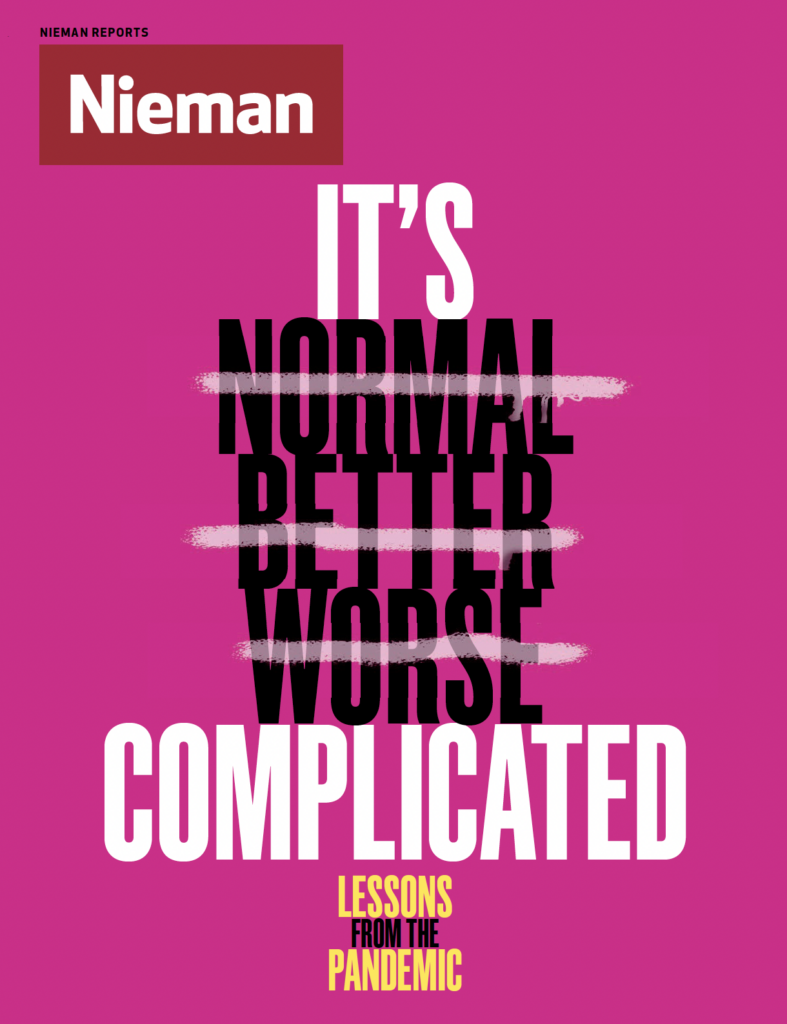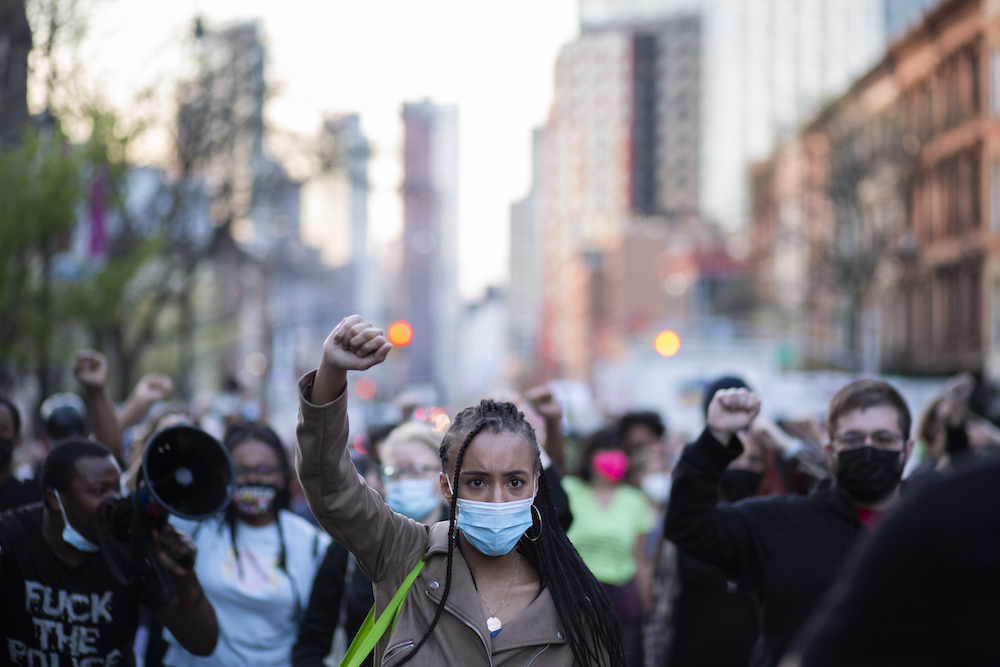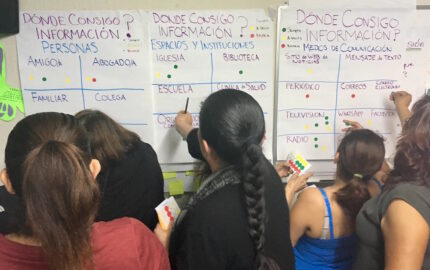
Hope that the coronavirus is finally being brought under control has prompted plans for a return to “normal.” But can, or should, journalism return to a pre-pandemic “normal?” Across newsrooms, the way we once covered education, sports, food, politics — any beat — is unlikely to be sufficient for the new moment we are entering.
What are the lasting lessons of this time? And how should we do journalism differently moving forward? These are the questions Nieman Reports explores in our essay series, Lessons from the Pandemic.
In March, when a man shot and killed eight people, including six women of Asian descent, across three different spas in the Atlanta area, one thing quickly became clear: the mainstream press wasn’t equipped to cover the news in the way that the local Korean press was.
Atlanta K, a small local Korean-language outlet run by Sang Yeon Lee, broke the news overnight that at least two of those killed were ethnic Koreans. Eventually, it was revealed that four of the women — Hyun Jung Grant, Yong Ae Yue, Suncha Kim, and Soon Chung Park — were spa workers of Korean descent. Much of the fuller reporting about the victims, including statements from their friends and families, originated from outlets like Lee’s, which were closely connected to and well sourced within the affected communities.
“Some readers … told me that they don’t trust mainstream media,” and some were disappointed by the way they were reporting, Lee says, pointing to other outlets’ preoccupation with the spa industry, rather than focusing on the lives of the women themselves.
But still, Lee says he helped national news reporters with the information he had and especially appreciated outlets that employed Korean American journalists who reached out for his opinion to better understand the context of the tragedy.
While the coverage in Atlanta starkly illustrated the need for community and immigrant-serving media outlets like Atlanta K, this sector — which includes a huge range, from companies like Telemundo to smaller outlets serving specific local communities — has long been vital. These outlets often report in languages other than English and serve local communities of color in ways that mainstream outlets are unable to. This has become especially clear during the pandemic, which has seen not only a global health crisis that disproportionately affects minority and immigrant communities, but also massive anti-police brutality protests, growing instances of anti-Asian violence, and undocumented workers who are left out of Covid relief efforts.
The term most often used for this sector is “ethnic media,” but this framework can also unintentionally other or stigmatize publications that are as critical as more mainstream, white-led outlets. CUNY’s Center for Community Media (CCM), for example, has dropped the word “ethnic” from its title. In this piece, the outlets referred to serve communities of color and immigrant communities.
Often thought of as alternatives to mainstream news — despite the fact that millions of people depend on these outlets — publications serving minority and immigrant communities have spent the past year getting vital information out about Covid testing, vaccine distribution, and relief money to people on the ground.
“We have Filipino publications really focusing on how Filipino health care workers were disproportionately affected by the pandemic … Vietnamese outlets, at least in California, they were able to write stories about how the nail salons are reacting to policy changes in the reopening,” says Chi Zhang, a researcher who authored a recent survey of outlets in California for the University of California, Riverside. “And last year, during the George Floyd protests, a lot of these publications were able to utilize the connections they had with local individuals and businesses and community leaders to really produce stories that are just not covered by mainstream media.”
Given the lasting impact of the coronavirus pandemic and the continuing struggles for racial justice, not to mention America’s changing demographics, publications serving minority and immigrant communities are likely to become even more integral to growing populations that rely on such publications to combat misinformation and report stories that might otherwise go unnoticed.
Lee, who has been working as a reporter at Korean-language news outlets in the United States for the past two decades, branched out on his own in 2019 to start Atlanta K, a digital-only outlet. While there were many printed Korean news sources, he felt that there wasn’t enough online-focused news for the local Korean community. A year after Lee started the publication, the pandemic hit. Since then, Atlanta K has covered essential issues, such as providing information on local vaccine distribution and debunking Covid-19 conspiracies and misinformation.
Lee notes how Atlanta K reports with more context for its audience than other outlets, like the fact that pro-Trump conspiracies are popular among the Korean community.
“Mainstream media doesn’t understand that,” Lee says. “They think the Asian community is all pro-Democrat, that they are all friendly to things like vaccines and face masks. But it’s not true because there are pro-Republican, pro-Trump people living here. I understand those kinds of things, I fought against those kinds of things.”
While the outlet lost ad revenue during the start of the pandemic last year, Lee says it has been easier for a digital publication like Atlanta K to financially weather the pandemic than print outlets. Lee says that Atlanta K is actually growing from local advertising and that he’s looking to hire a second-generation Korean journalist to write for the site in English.
The same can’t be said for the sector overall, which, like the media industry as a whole, has been hit hard over the past year. Zhang surveyed ethnic media outlets in California from April to May 2020, finding that the pandemic wiped out half of the sector’s revenue in the state, with a quarter of outlets reporting a revenue loss of more than 70%. While audiences grew during the pandemic for nearly half of the surveyed outlets — reflecting their importance for readers — this didn’t necessarily translate into advertising revenue, which is how the majority of these outlets make money.
And yet it’s those same communities that have been disproportionately affected by the pandemic.

“Communities that have been hardest hit by the pandemic are probably not the communities reading the mainstream outlets. These are immigrant communities, brown and Black communities, that have been decimated,” says Daniela Gerson, assistant professor of journalism at California State University, Northridge, who authored a recent report highlighting how outlets are managing to sustain themselves during the pandemic.
For this sector, these kinds of financial challenges are not new; 28% of the California outlets surveyed were operating at a loss even before the pandemic. According to Gerson, in addition to facing the same types of business model challenges as mainstream media overall, over the past few decades, community and immigrant-serving outlets have also had to deal with competition from home-country news sites, which can now be read online, as well as social media serving as a way for people to get service-oriented news.
“An old challenge and big issue for community media, and media particularly serving communities of color and immigrant communities, has been access to capital,” Graciela Mochkofsky, executive director of CUNY’s CCM, says, “both in the commercial advertising world and also now grant funding and platform funding.”
While the sector is incredibly varied, for many community and immigrant-serving outlets that were relying on advertising from small local businesses and event-based revenue, the pandemic cut into already-tight budgets. Alexis Terrazas, editor in chief of El Tecolote, a 50-year-old paper serving the Latino community in San Francisco’s Mission District, says that last year the paper lost the steady revenue from running a bingo game every week.
Similarly, Anh Do, a Los Angeles Times reporter and board member of the Nguoi Viet Daily News, a Vietnamese newspaper started by her father, says they had to pause events at the community center attached to the paper’s headquarters in Orange County, California.
“It was a space that the community is comfortable and familiar with,” Do says of the auditorium the outlet rented out for all kinds of events, from health fairs to recruiting workshops. “While the revenue that Nguoi Viet pulled in from it wasn’t huge, it was very steady, very reliable, and it was a way that the newspaper expanded its reach.” Because of that lost revenue, along with steep cuts in print advertising, the paper laid off around 15 people out of its 100-person staff during the pandemic.
Garry Pierre-Pierre, editor of The Haitian Times, a now digital-only paper based in Brooklyn, New York, serving the Haitian diaspora, also saw a rash of cancellations when Covid hit from the event-based advertisers on which the publication relied.
“Events just dried up overnight, for obvious reasons. So, I’m thinking, that’s it. I’m going to shut the site. There’s no way we can continue,” Pierre-Pierre says.
But the paper actually saw growth in revenue, traffic, and subscribers, which Pierre-Pierre credited to a New York City executive order that recently went into effect, mandating that at least 50% of the city’s print and online advertising would go to community media outlets.
“Overnight we went from thinking we’re going to close the shop to expanding the shop,” Pierre-Pierre says.
This is just one example of how local governments can play a role in helping sustain some of the country’s most vital media outlets, which, like the media sector as a whole as some have argued, will need to see an increase in public funding overall. The executive order was advocated for by the CCM, which now helps connect city agencies with the publishers who will get the advertisements — from Covid vaccine locations to census information – to the communities they’re trying to reach.
A CCM white paper published in 2013 found that while community and immigrant-facing publications had a circulation rate that reached 55% of the city’s population, they were only receiving 18% of the city’s ad budget.
Mochkofsky points out that it’s a win-win situation for city governments and community media outlets, with the CCM now trying to get similar legislation passed in other states and cities, like California and Chicago.
“The city needs to engage with residents, and we talk to the residents,” as Pierre-Pierre puts it. “That’s always been the case.”

It’s been undeniable during the pandemic that community and immigrant-facing media outlets have provided a kind of service reporting that’s been essential in getting information to people who need it. Outlets like Sahan Journal, a St. Paul-based nonprofit dedicated to reporting for immigrants and communities of color in Minnesota, have been on the ground providing crucial reporting on the George Floyd protests and the Derek Chauvin verdict year round, from the perspective of reporters of color. And then there are the publications providing in-language reporting on platforms where their audiences already are, whether it’s posting on messaging apps like WeChat and KaKaoTalk or using video or audio for audiences that might face linguistic barriers.
One such outlet is Radio Indígena, a project that came out of the nonprofit Mixteco/Indígena Community Organizing Project that organizes indigenous farmworkers along California’s Central Coast. The radio station, which started in 2014 as online-only and now includes an FM station after raising $20,000 through a community fundraising drive, reaches some of the people with the least access to information because it reports in indigenous languages like Mixtec and Zapotec as well as Spanish.
Since Covid hit a year ago last March, Arcenio López, executive director of the nonprofit, says Radio Indígena has been translating CDC information into these languages, explaining how to download Zoom, and how to apply for the housing and food assistance programs that are available for its undocumented audiences. While the audience numbers are difficult to quantify, López estimates that they get around 4,000 daily listeners on their FM station and thousands more through online platforms like Facebook Live.
López says he knew the station was getting essential information out when one of its organizers tried to provide Covid vaccine outreach to farmworkers and asked for authorization from a workplace supervisor to enter the field. The organizer was denied entry when the employer found out they were associated with Radio Indígena.
“The supervisor said, ‘No, we cannot allow you to go in because you’re providing so much information about workers’ rights,’” López recalls, laughing. “I was not mad. That’s actually really good proof for me that we’re doing a good job.”
During the pandemic, El Tecolote’s Terrazas realized their Spanish-language coverage wasn’t going to reach all of the indigenous Mayan community. So, they recruited a Mayan food industry worker to interview a health worker at a vaccine distribution site.
“That video went really far within our Mayan community,” Terrazas says. “There’s this narrative of vaccine hesitancy that’s out there, but we also found that a lot of folks, especially frontline food workers, were like, ‘No, I’m going to get the vaccine,’ and it encouraged and showed these Mayan folks how to get it.”
Despite continuous financial and visibility challenges, many community and immigrant-facing outlets are finding ways to survive and grow even now. Outlets that have been able to embrace the shift to digital platforms have done especially well, according to California State University’s Gerson.
Last summer, “working on that report, I was thinking it could be pretty dark,” says Gerson, referring to her research on commercial survival strategies during the pandemic. “There are a lot of reasons immigrant-serving media outlets are facing challenges that go beyond local media outlets. But I also found there were really exciting ways that immigrant-serving outlets were growing and innovating and there are lessons for the media as a whole.”
The report found, for example, that outlets that are using social media platforms to develop community engagement and diversifying their business streams beyond a reliance on print ads are faring especially well.
One of the other main lessons: Cultivating a relationship with the audience.
While traditional media outlets are facing a crisis in trust, experts and publishers agree that community-based media outlets are not seeing the same problem.
“Most of the community media outlets, because they were community-based and really made by people in the community they serve, that wasn’t an issue,” says CUNY’s Mochkofsky. “Everyone saw this enormous spike in traffic and in readership because in a crisis, that’s where people turn.”
Yet that growth doesn’t necessarily translate into revenue, especially when advertisers from bigger companies often overlook community media outlets. And even for publications that follow a nonprofit model, like Radio Indígena, there’s always the issue of sustainability. The pandemic has shown funders the greater need for such outlets — especially as an informational tool in the time of social distancing and mis- and disinformation — but López says it’s still a precarious endeavor: “Radio was hard to sustain before the pandemic, let’s put it that way. We don’t know what to expect tomorrow.”
Such media outlets, like the communities they serve, can’t just depend on visibility during a crisis; that’s why ad initiatives like the program in New York City can serve as an essential part of public infrastructure.
“There are still a lot of changes that need to be done in terms of recognizing the importance of these outlets, [especially] of smaller-sized media like ours,” López says. “We only see things for us when we are in a crisis or a pandemic moment. I think this is just another call for these [kinds of] government funding.”



